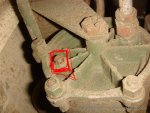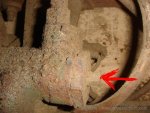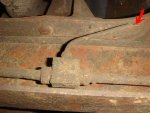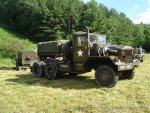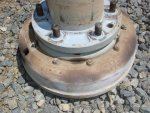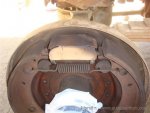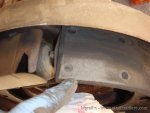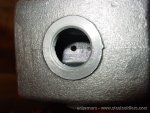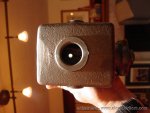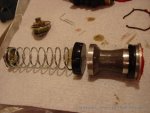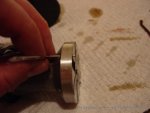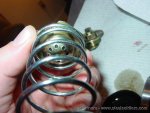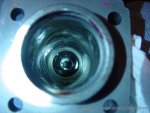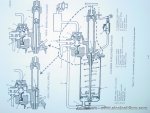It is very important that when the brake pedal is released that the master cylinder pushrod have a mechanical gap between the pushing end and the master cylinder receiving cup. This assures allowing the master cylinder piston to bottom out opening the vent port in the piston which connects the master cylinder's fluid reservoir to the brake line, dumping the brake line pressure.
Since this important gap is hidden from being easily measured or viewed by the master cylinder's cup shaped input and rubber dust boot, in the TM you set this gap instead by adjusting the brake pedal freeplay.
There is a chance to miconscrue the squishy inital feel of the brake shoe contact with the drums into the stiff feel of direct force transfer between pedal and wheels as as freeplay, since at least on my truck that squishy distance was within the desired freeplay spec. But that is not the freeplay you are desiring to introduce. You actually want the brake pedal freeplay to be an honest to gosh mechanical gap / slop between the pedal linkage pushrod and the master cylinder piston input cup.
This is important because the air pack works due to differential pressure between the master cylinder line and the wheel brake line(s). It doesn't amplify the master cylinder pressure, it amplifies the quantity of brake fluid flow. Small quantity from the master cylinder, larger quantity to all the wheel cylinders, same pressure both sides.
Higher master cylinder pressure than wheel line pressure causes the air pack piston to move to push more fluid into the wheel lines. Lower master cylinder pressure than wheel line pressure lets the air pack return fluid to the master cylinder and the air pack piston moves to draw in fluid from the wheel cylinders.
However, NO differential pressure between the master cylinder and the wheel lines, and the air pack piston is happy staying wherever it is. The piston doesn't move either way. although with vibration and what not it seems to be biased towards slowly pushing out. This lack of difference pressure doesn't meen there is no pressure. This is the condition I believe you are in when the brakes are slowly applying themselves and you get increasingly hard brake pedal feel. The air pack piston is slowly pushing the fluid out of the air pack but there's no differential pressure buildup to correct the issue.
I shared a "brakes slowly applying themselves" near death experience with my father in law on our first night out with my 'new to me M185A3'. I entered slightly distracted into what turned out to be a hairpin exit ramp far too fast, was afflicted with a rather poorly timed total brake loss (momentary function then pedal to the floor), and pretty sure I got the truck up onto 5 wheels before deciding I'd rather go straight thru the guardrail and kill the truck and than die rolling it sideways. Pretty stinkin scarey...
But with the help of that guard rail and a still inexplicable miracle, and maybe even some slow motion, we returned to weight on wheels, remained on the off ramp, and were able to cautiously get into a conveinence store parking lot.
Before the shock of the whole situation had completely wore off I got to use one of my brand new fire extinguishers to extinguish the subsequent fluid fed brake fire.
We misdiagnosed the whole ordeal as having been caused by a hung wheel cylinder, and replaced all 6 wheel cylinders, shoes, and a drum. Didn't want that to happen again, ever. Of course it did, except based on the recent experience we figured it out before it got dangerous.
Next I replaced the air pack. 35 driving minutes later we were stopped again on the side of the road, brakes firmly set, waiting for them to release themselves while our rental car was being delivered. After contemplating Virginia's beautiful autumn foilage for awhile, found the brakes weren't releasing themselves and wouldn't release when I dumped the air resevoirs. Called to my parts supplier and learned that I needed to vent the fluid out of the wheel cylinders to make things right again. That worked, found a good place to leave the truck and took the rental to the airport to go back home.
I had weeks to study up on the system and mull my problems over and over. I decided to replace the air pack again, it was the only thing that could activate the brakes. I must've got a bad one. Back at the truck, we bought all the remaining DOT5 fluid in Franklin, changed out the air pack for the second time, installed a cab mounted brake fluid reservoir on (a la Roscoe Equipment's project instructions), put a BrakeSmart hydraulic pressure sensing trailer brake controller on, and got the brake shoes adjusted to the TM specs.
That didn't fix it either. At least with the brake adjustment all 6 wheels were heating up evenly, where prior they were heating unevenly. But with the bleeding workaround, travelled all the way from Franklin, Virginia to Cedar Park, Texas stopping every 30 to 55 minutes along the way to dump a tablespoon or so of fluid to keep the creeping pressure below the shoe/drum contact point.
The pressure at which the brakes start to drag seemed to be around 30 psi. This is below the threshold for the Brakesmart display so I had to figure this out from meter readings. After each bleeding the pressure read zero. After any brake application my pressure read maybe 15 psi, and from there it would slowly creep up till the brakes started dragging.
I read on the internet that once a shoe starts to drag, the heat warms the brake fluid in that wheel cylinder which causes it to expand, which makes the shoe drag harder, increasing the heat which increases the pressure, etc. until the fluid starts boiling or until a cylinder seal fails.
In Cedar Park, Texas, where the Comfort Inn there has a Texas shaped waffle iron, in an effort to delay our mornings departure in the hope that the light rain would clear up shortly, I finally discovered the real cause of my $6000+ problem - the master cylinder pushrod was mis-rigged.
The fact that the brake pedal gets harder (pushes back more and more) as you drive indicates that there is pressure pushing back against the master cylinder piston. Where does this pressure come from? It can come from the expanding oil or from the air pack piston pushing fluid out of the air pack. When the air pack piston moves, it works like a second master cylinder, working the wheel cylinders this also pushing back on the actual master cylinder, which is felt on the brake pedal.
But how can the air pack push back on the brake pedal? Well as long as the brake pedal is being pushed by your foot, or by the pushrod being adjusted too long, the air pack piston can push back against it just fine.
But at the very end of its travel, the master cylinder does one more thing that even after I had read through it several times it didn't really click how important it was... At the end of its travel, the master cylinder vents the brake line fluid back into its reservoir. Zero psig. No significant pressure can develope on the brake line with the vent port open.
So if the pedal's released and the pushrod is not too long, the master cylinder will be pushed back by any back pressure (as well as its internal spring) until the vent port is opened, dumping any pressure to the reservoir. With no pressure on the master cylinder side and residual pressure on the wheel cylinder side the air pack piston will be moved full brakes released.



